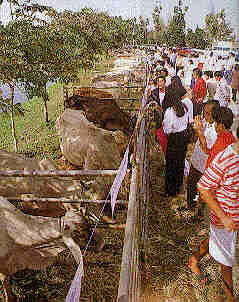
The pen with the names of the farmers receiving the service from the Buffalo Bank
-
"Buffalo bank is a concept in which buffaloes and oxen are put together under a proper accounting system for due maintenance, distribution and rental for various purposes. Following the banking system, it is designed to benefit agriculture while increasing the number of buffaloes."
- "The buffalo babk is a truly new concept that arises from the necessity of the present when machinery is widely used in agribusiness. The rising prices of gasoline make machinery less cost-effective, so farmers have to turn to the animals which they used to rely upon before machinery took over. But the return proves to be problematic, as money is needed to buy buffaloes to work on the fields."